Emerging Contaminants in Landfill Leachate and Groundwater: A Case Study of Hazardous Waste Landfill and Municipal Solid Waste Landfill in Northeastern China
Abstract
1. Introduction
2. Case Study Areas, Sampling, and Analysis of Data
2.1. Study Area
2.2. Geology and Hydrogeology
2.3. Sampling and Analysis of Data
- (1)
- Perfluorinated compounds (PFCs): perfluorobutanoic acid (PFBA), perfluorovaleric acid (PFPeA), perfluorohexanoic acid (PFHxA), perfluoroheptanoic acid (PFHpA), perfluorooctanoic acid (PFOA), perfluorononanoic acid (PFNA), perfluorodecanoic acid (PFDA), perfluoroundecanoic acid (PFUnDA), perfluorododecanoic acid (PFDoA), perfluorotridecanoic acid (PFTriDA), perfluorotetradecanoic acid (PFTeDA), perfluorohexadecanoic acid (PFHxDA), perfluorooctadecanoic acid (PFOdA), perfluorobutane sulfonate (PFBS), perfluorohexane sulfonate (PFHxS), perfluorooctane sulfonate (PFOS), perfluorodecane sulfonate (PFDS).
- (2)
- Antibiotics: tetracycline (TET), oxytetracycline (OXY), chlortetracycline (CHT), penicillin (PC), doxycycline (DC), spiramycin (SPM), erythromycin (ETM), clarithromycin (CLR), azithromycin (AZM), roxithromycin (ROX), tylosin (TYL), norfloxacin (NOR), ciprofloxacin (CIP), pefloxacin (PEF), enrofloxacin (ENR), ofloxacin (OFL), difloxacin (DIF), lomefloxacin (LOM), sulfadiazine (SDZ), sulfamonomethoxine (SMM), sulfadimidine (SDM), sulfadimethoxypyrimidine (SDT), sulfamethoxazole (SMX), ulfathiazole (STZ), sulfamerazine (SMZ), sulfachloropyridazine (SCP), sulfapyridine (SPY), sulfisoxazole (SIZ), trimethoprim (TMP).
- (3)
- Alkylphenols (APs): 4-tert-butylphenol (4-t-BP), 4-butylphenol (4-BP), 4-pentylphenol (4-PP), 4-hexylphenol (4-HxP), 4-tertoctylphenol (4-t-OP), 4-heptylphenol (4-HpP), 4-octylphenol (4-OP), 4-nonylphenol (4-NP).
- (4)
- Pentachlorophenol (PCP).
- (5)
- Poly brominated diphenyl ethers (PBDEs).
- (6)
- Hexabromocyclododecane (HBCD): α-HBCD, β-HBCD, γ-HBCD.
- (7)
- Tetrabromobisphenol A (TBBPA).
- (8)
- Hexachlorobutadiene (HCBD).
- (9)
- Bisphenol A (BPA).
3. Results
3.1. ECs in Leachate
3.2. Groundwater ECs
3.3. Comparison of Groundwater and Leachate ECs
4. Discussion
4.1. Differences in ECs among the Case-Study Landfills
4.2. The Effect of Landfill Operational Years on ECs in Groundwater
4.3. The Effects of Various Impermeable Conditions on the Groundwater Environment
5. Conclusions
Supplementary Materials
Author Contributions
Funding
Data Availability Statement
Conflicts of Interest
References
- Rosenfeld, P.E.; Feng, L.G.H. 16—Emerging Contaminants. In Risks of Hazardous Wastes; Rosenfeld, P.E., Feng, L.G.H., Eds.; William Andrew Publishing: Boston, MA, USA, 2011; pp. 215–222. [Google Scholar]
- Grandjean, P. Delayed discovery, dissemination, and decisions on intervention in environmental health: A case study on immunotoxicity of perfluorinated alkylate substances. Environ. Health 2018, 17, 62. [Google Scholar] [CrossRef] [PubMed]
- Blum, A.; Balan, S.A.; Scheringer, M.; Trier, X.; Goldenman, G.; Cousins, I.T.; Diamond, M.; Fletcher, T.; Higgins, C.; Lindeman, A.E.; et al. The Madrid Statement on Poly- and Perfluoroalkyl Substances (PFASs). Env. Health Perspect. 2015, 123, A107–A111. [Google Scholar] [CrossRef] [PubMed]
- Abou-Elwafa Abdallah, M.; Wemken, N.; Drage, D.; Tlustos, C.; Cellarius, C.; Cleere, K.; Morrison, J.; Daly, S.; Coggins, M.; Harrad, S. Concentrations of perfluoroalkyl substances in human milk from Ireland: Implications for adult and nursing infant exposure. Chemosphere 2019, 246, 125724. [Google Scholar] [CrossRef] [PubMed]
- Fuertes, I.; Gómez-Lavín, S.; Elizalde, M.P.; Urtiaga, A. Perfluorinated alkyl substances (PFASs) in northern Spain municipal solid waste landfill leachates. Chemosphere 2017, 168, 399–407. [Google Scholar] [CrossRef] [PubMed]
- Yi, X.; Tran, N.H.; Yin, T.; He, Y.; Gin, K.Y.-H. Removal of selected PPCPs, EDCs, and antibiotic resistance genes in landfill leachate by a full-scale constructed wetlands system. Water Res. 2017, 121, 46–60. [Google Scholar] [CrossRef]
- Masoner, J.R.; Kolpin, D.W.; Furlong, E.T.; Cozzarelli, I.M.; Gray, J.L.; Schwab, E.A. Contaminants of emerging concern in fresh leachate from landfills in the conterminous United States. Environ. Sci. Process. Impacts 2014, 16, 2335–2354. [Google Scholar] [CrossRef]
- Barnes, K.K.; Kolpin, D.W.; Furlong, E.T.; Zaugg, S.D.; Meyer, M.T.; Barber, L.B. A national reconnaissance of pharmaceuticals and other organic wastewater contaminants in the United States—I) Groundwater. Sci. Total Environ. 2008, 402, 192–200. [Google Scholar] [CrossRef]
- Erickson, M.L.; Langer, S.K.; Roth, J.L.; Kroening, S.E. Contaminants of Emerging Concern in Ambient Groundwater in Urbanized Areas of Minnesota, 2009-12; 2014-5096; U.S. Geological Survey: Reston, VA, USA, 2014; p. 50. [Google Scholar]
- Chen, Q.-L.; Li, H.; Zhou, X.-Y.; Zhao, Y.; Su, J.-Q.; Zhang, X.; Huang, F.-Y. An underappreciated hotspot of antibiotic resistance: The groundwater near the municipal solid waste landfill. Sci. Total Environ. 2017, 609, 966–973. [Google Scholar] [CrossRef]
- Yan, H.; Cousins, I.T.; Zhang, C.; Zhou, Q. Perfluoroalkyl acids in municipal landfill leachates from China: Occurrence, fate during leachate treatment and potential impact on groundwater. Sci. Total Environ. 2015, 524–525, 23–31. [Google Scholar] [CrossRef]
- Yu, X.; Sui, Q.; Lyu, S.; Zhao, W.; Cao, X.; Wang, J.; Yu, G. Do high levels of PPCPs in landfill leachates influence the water environment in the vicinity of landfills? A case study of the largest landfill in China. Environ. Int. 2020, 135, 105404. [Google Scholar] [CrossRef]
- Yu, X.; Sui, Q.; Lyu, S.; Zhao, W.; Liu, J.; Cai, Z.; Yu, G.; Barcelo, D. Municipal Solid Waste Landfills: An Underestimated Source of Pharmaceutical and Personal Care Products in the Water Environment. Environ. Sci. Technol. 2020, 54, 9757–9768. [Google Scholar] [CrossRef] [PubMed]
- Buszka, P.M.; Yeskis, D.J.; Kolpin, D.W.; Furlong, E.T.; Zaugg, S.D.; Meyer, M.T. Waste-indicator and pharmaceutical compounds in landfill-leachate-affected ground water near Elkhart, Indiana, 2000–2002. Bull. Environ. Contam. Toxicol. 2009, 82, 653–659. [Google Scholar] [CrossRef] [PubMed]
- Musson, S.E.; Townsend, T.G. Pharmaceutical compound content of municipal solid waste. J. Hazard. Mater. 2009, 162, 730–735. [Google Scholar] [CrossRef] [PubMed]
- You, X.; Wu, D.; Wei, H.; Xie, B.; Lu, J. Fluoroquinolones and β-lactam antibiotics and antibiotic resistance genes in autumn leachates of seven major municipal solid waste landfills in China. Environ. Int. 2018, 113, 162–169. [Google Scholar] [CrossRef]
- Sui, Q.; Zhao, W.; Cao, X.; Lu, S.; Qiu, Z.; Gu, X.; Yu, G. Pharmaceuticals and personal care products in the leachates from a typical landfill reservoir of municipal solid waste in Shanghai, China: Occurrence and removal by a full-scale membrane bioreactor. J. Hazard. Mater. 2017, 323, 99–108. [Google Scholar] [CrossRef]
- Arukwe, A.; Eggen, T.; Möder, M. Solid waste deposits as a significant source of contaminants of emerging concern to the aquatic and terrestrial environments—A developing country case study from Owerri, Nigeria. Sci. Total Environ. 2012, 438, 94–102. [Google Scholar] [CrossRef]
- Liu, T.; Hu, L.-X.; Han, Y.; Dong, L.-L.; Wang, Y.-Q.; Zhao, J.-H.; Liu, Y.-S.; Zhao, J.-L.; Ying, G.-G. Non-target and target screening of per- and polyfluoroalkyl substances in landfill leachate and impact on groundwater in Guangzhou, China. Sci. Total Environ. 2022, 844, 157021. [Google Scholar] [CrossRef]
- Lietz, A.C.; Meyer, M.T. Evaluation of Emerging Contaminants of Concern at the South District Wastewater Treatment Plant Based on Seasonal Sampling Events, Miami-Dade County, Florida, 2004; 2006-5240; U.S. Geological Survey: Reston, VA, USA, 2006; p. 46. [Google Scholar]
- Long, W.; Wenjing, C.; Yang, Z.; Long, D.; Yunxiao, C.; Yan, Z.; Dan, Z.; Guangxin, Z.; Jian, W.; Gang, C. Status quo of PFOS/PFOSF environmental management and the countermeasures of waste pollution control in China. Environ. Prot. Sci. 2024, 50, 1–9. [Google Scholar] [CrossRef]
- Wang, K.; Reguyal, F.; Zhuang, T. Risk assessment and investigation of landfill leachate as a source of emerging organic contaminants to the surrounding environment: A case study of the largest landfill in Jinan City, China. Environ. Sci. Pollut. Res. 2021, 28, 18368–18381. [Google Scholar] [CrossRef]
- Paul, A.G.; Jones, K.C.; Sweetman, A.J. A First Global Production, Emission, And Environmental Inventory For Perfluorooctane Sulfonate. Environ. Sci. Technol. 2009, 43, 386–392. [Google Scholar] [CrossRef]
- Prevedouros, K.; Cousins, I.T.; Buck, R.C.; Korzeniowski, S.H. Sources, Fate and Transport of Perfluorocarboxylates. Environ. Sci. Technol. 2006, 40, 32–44. [Google Scholar] [CrossRef] [PubMed]
- Hepburn, E.; Madden, C.; Szabo, D.; Coggan, T.L.; Clarke, B.; Currell, M. Contamination of groundwater with per- and polyfluoroalkyl substances (PFAS) from legacy landfills in an urban re-development precinct. Environ. Pollut. 2019, 248, 101–113. [Google Scholar] [CrossRef] [PubMed]
- Eschauzier, C.; Raat, K.J.; Stuyfzand, P.J.; De Voogt, P. Perfluorinated alkylated acids in groundwater and drinking water: Identification, origin and mobility. Sci. Total Environ. 2013, 458–460, 477–485. [Google Scholar] [CrossRef] [PubMed]
- Hirsch, R.; Ternes, T.; Haberer, K.; Kratz, K.L. Occurrence of antibiotics in the aquatic environment. Sci. Total Environ. 1999, 225, 109–118. [Google Scholar] [CrossRef]
- Kümmerer, K.; Al-Ahmad, A.; Mersch-Sundermann, V. Biodegradability of some antibiotics, elimination of the genotoxicity and affection of wastewater bacteria in a simple test. Chemosphere 2000, 40, 701–710. [Google Scholar] [CrossRef]
- Lu, M.-C.; Chen, Y.Y.; Chiou, M.-R.; Chen, M.Y.; Fan, H.-J. Occurrence and treatment efficiency of pharmaceuticals in landfill leachates. Waste Manag. 2016, 55, 257–264. [Google Scholar] [CrossRef]
- Tran, N.H.; Reinhard, M.; Gin, K.Y.-H. Occurrence and fate of emerging contaminants in municipal wastewater treatment plants from different geographical regions—A review. Water Res. 2018, 133, 182–207. [Google Scholar] [CrossRef]
- Ratola, N.; Cincinelli, A.; Alves, A.; Katsoyiannis, A. Occurrence of organic microcontaminants in the wastewater treatment process. A mini review. J. Hazard. Mater. 2012, 239–240, 1–18. [Google Scholar] [CrossRef]
- Zhang, X.-H.; Xu, Y.-B.; He, X.-L.; Huang, L.; Ling, J.-Y.; Zheng, L.; Du, Q.-P. Occurrence of antibiotic resistance genes in landfill leachate treatment plant and its effluent-receiving soil and surface water. Environ. Pollut. 2016, 218, 1255–1261. [Google Scholar] [CrossRef]
- Kovarova, J.; Blahova, J.; Divisova, L.; Svobodova, Z. Alkylphenol ethoxylates and alkylphenols--update information on occurrence, fate and toxicity in aquatic environment. Pol. J. Vet. Sci. 2013, 16, 763–772. [Google Scholar] [CrossRef]
- Vandenberg, L.N.; Chahoud, I.; Heindel, J.J.; Padmanabhan, V.; Paumgartten, F.J.R.; Schoenfelder, G. Urinary, circulating, and tissue biomonitoring studies indicate widespread exposure to bisphenol A. Environ. Health Perspect. 2010, 118, 1055–1070. [Google Scholar] [CrossRef]
- Harrad, S.; Drage, D.S.; Sharkey, M.; Berresheim, H. Perfluoroalkyl substances and brominated flame retardants in landfill-related air, soil, and groundwater from Ireland. Sci. Total Environ. 2020, 705, 135834. [Google Scholar] [CrossRef]
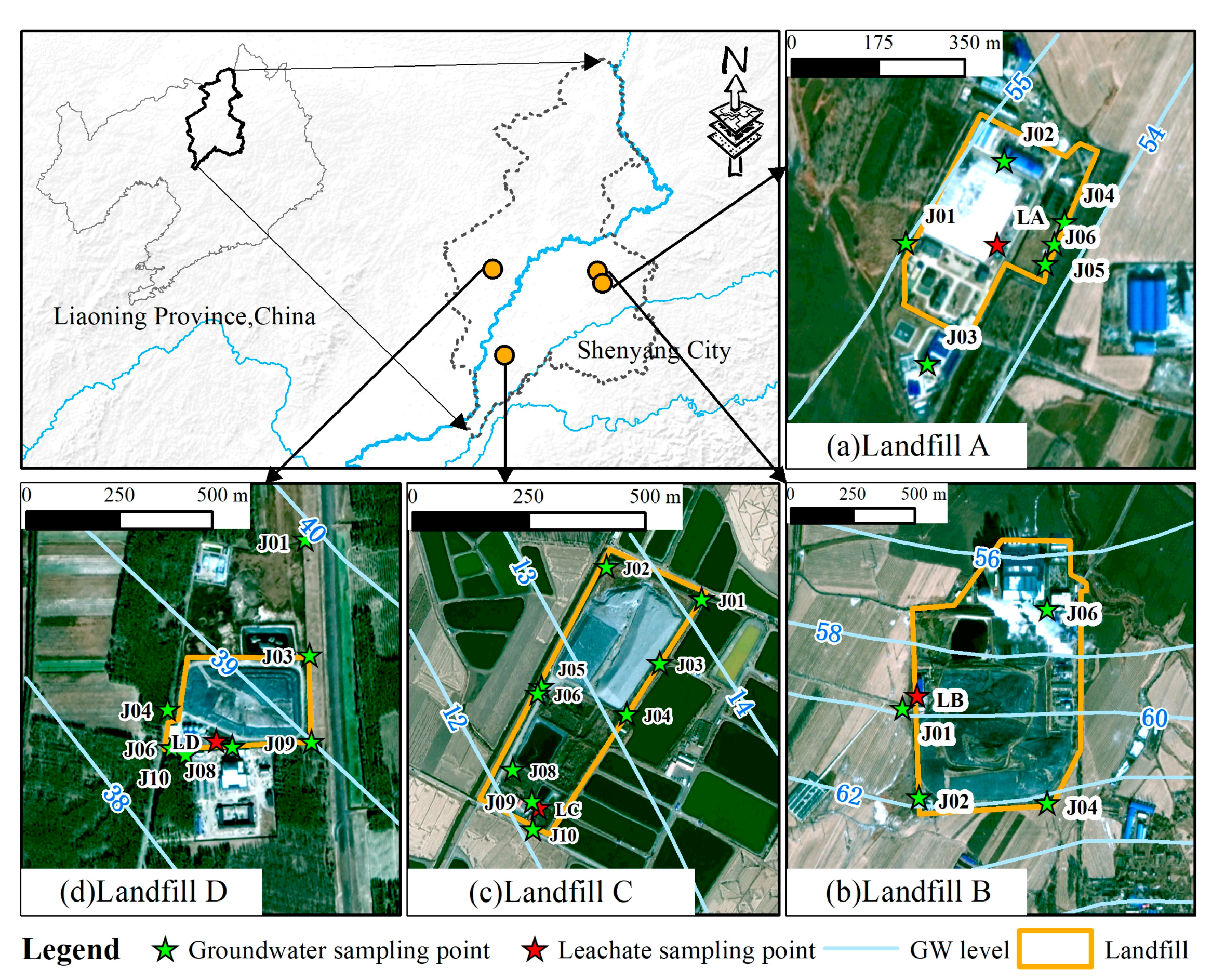
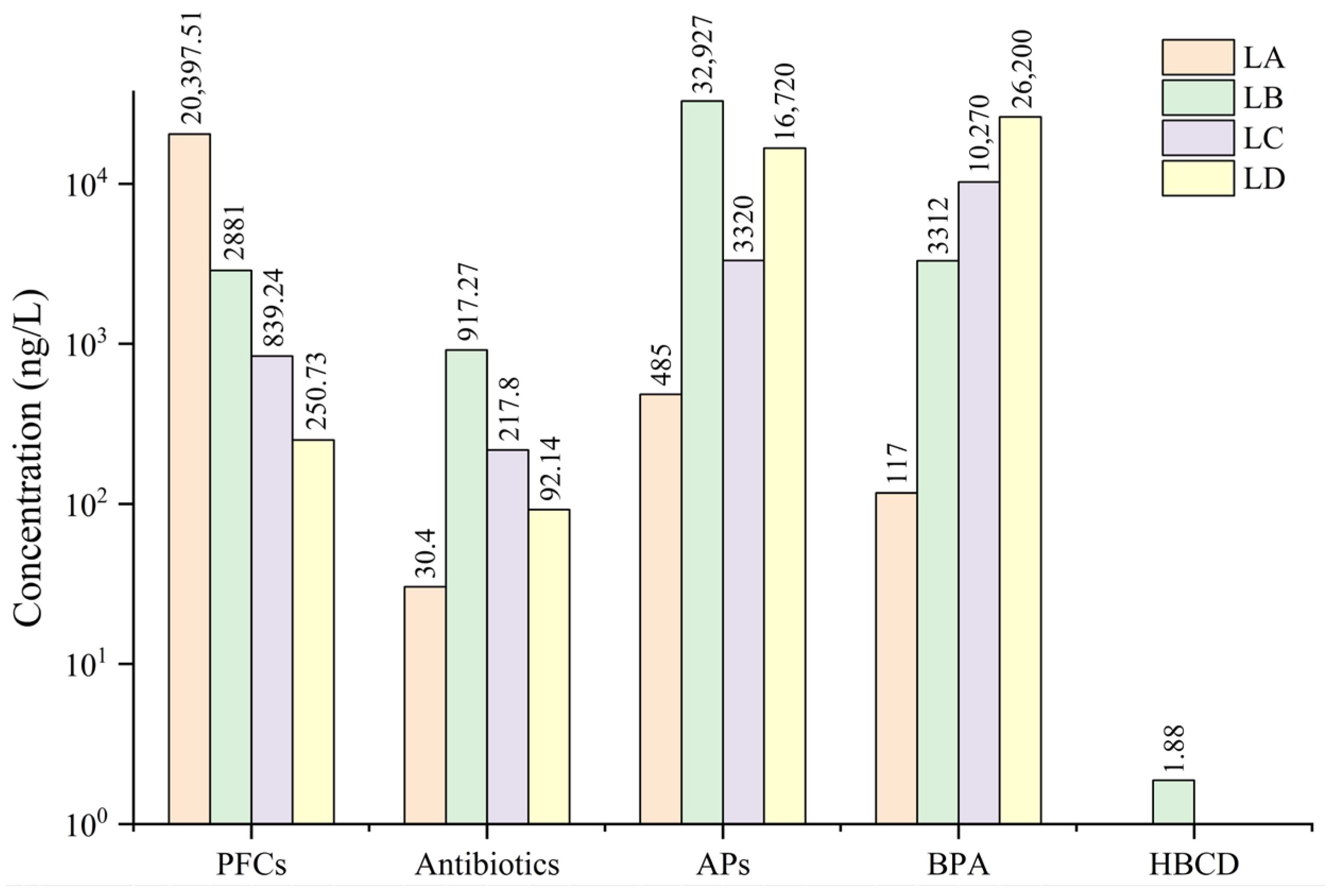
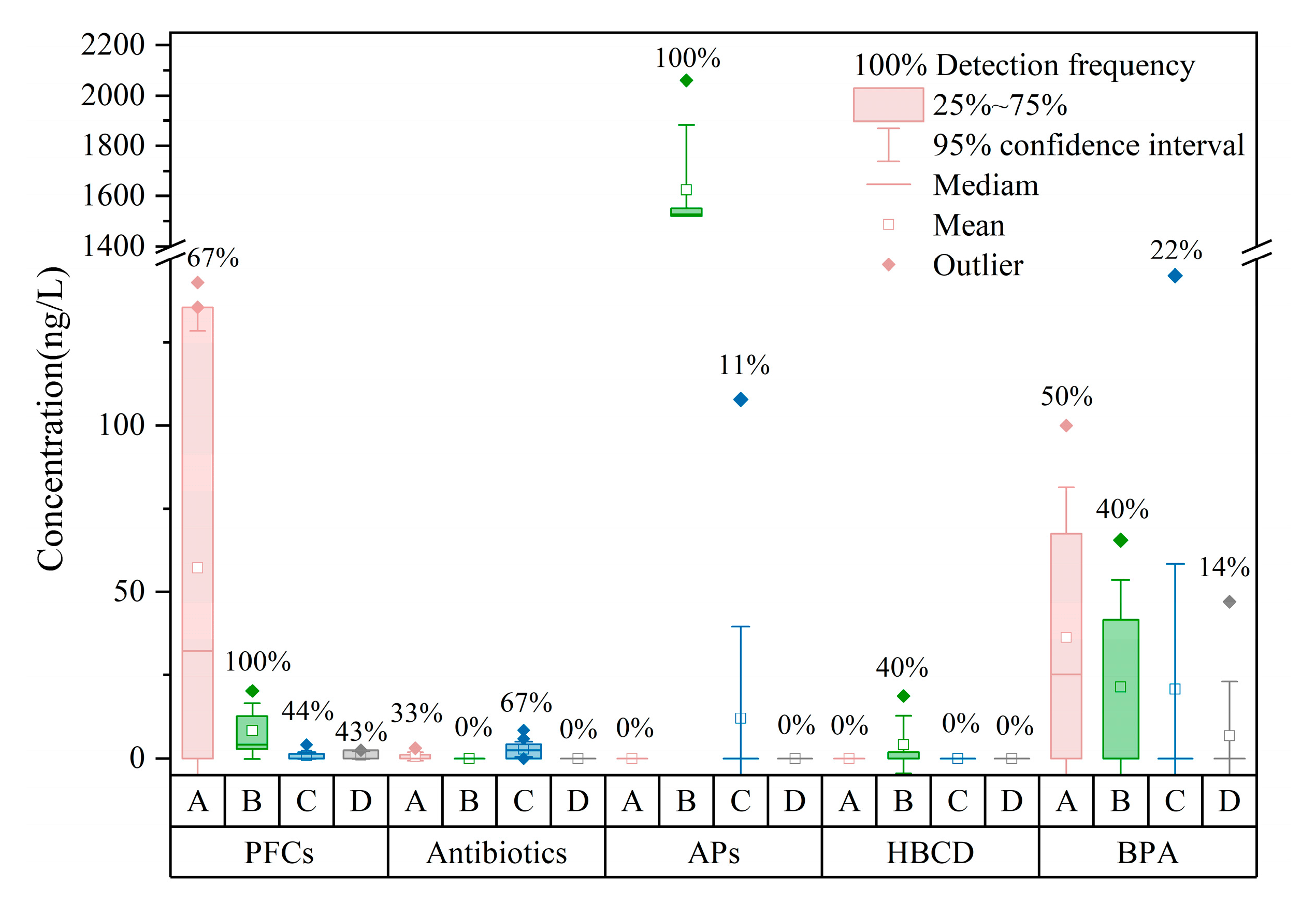
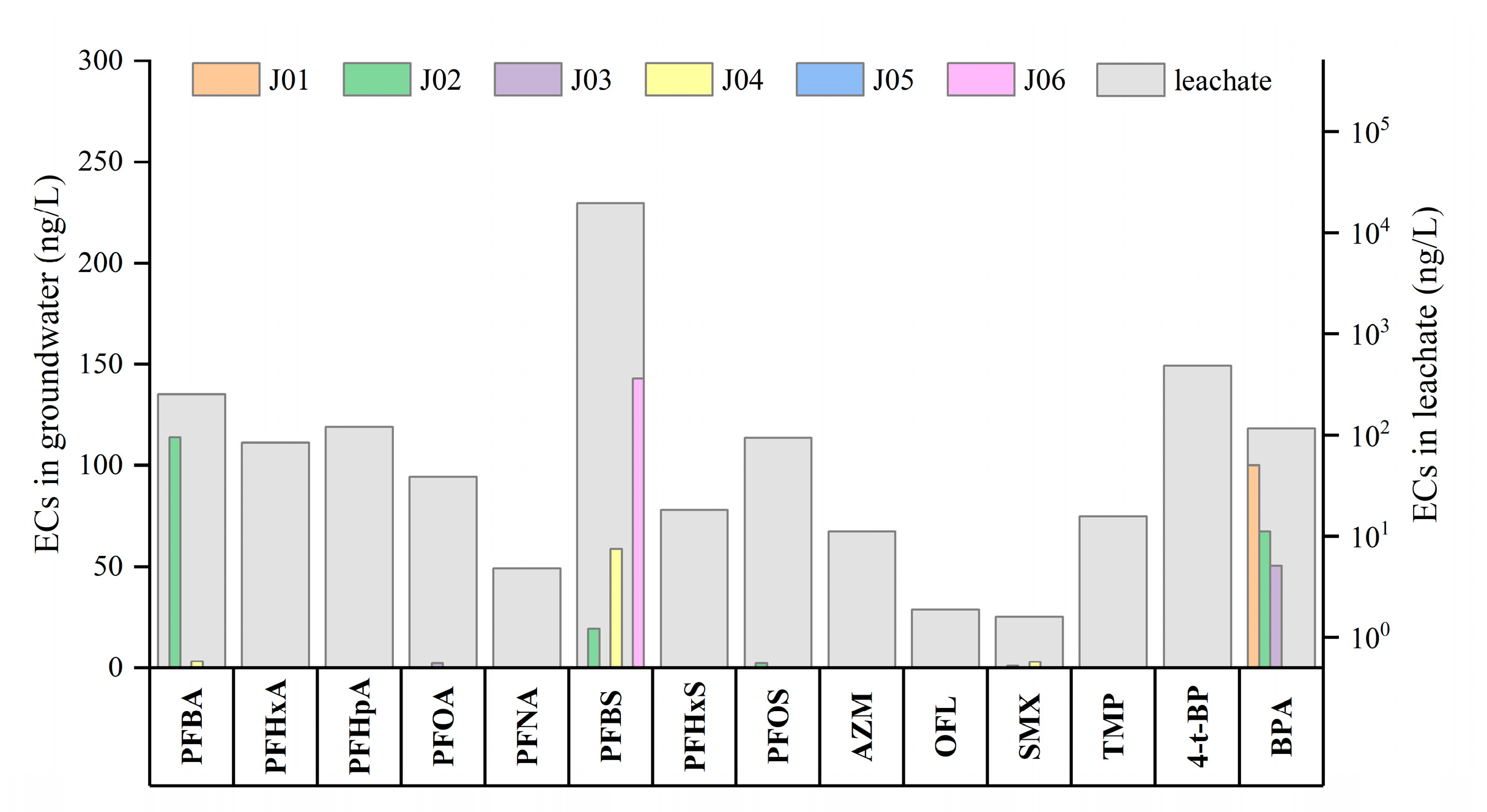
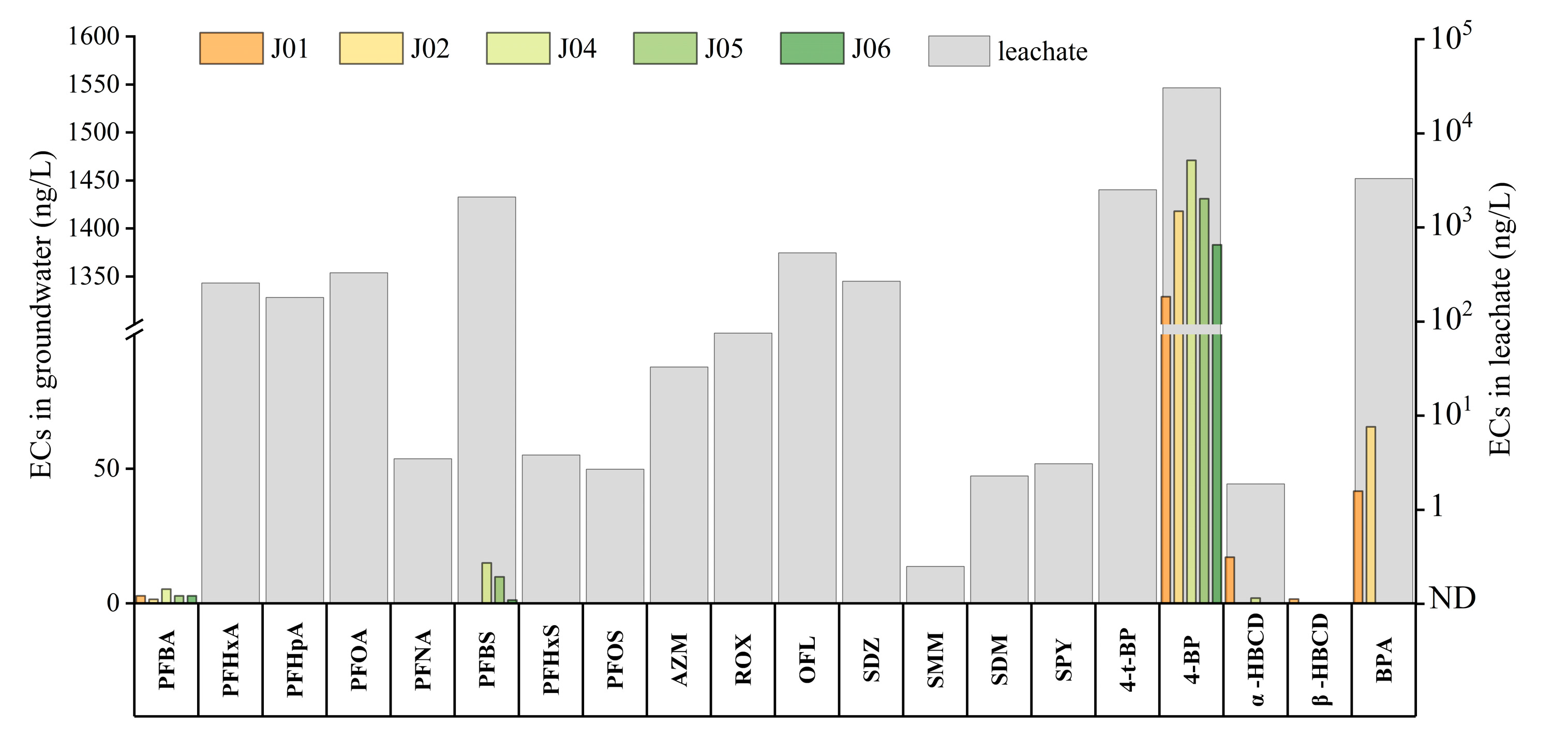
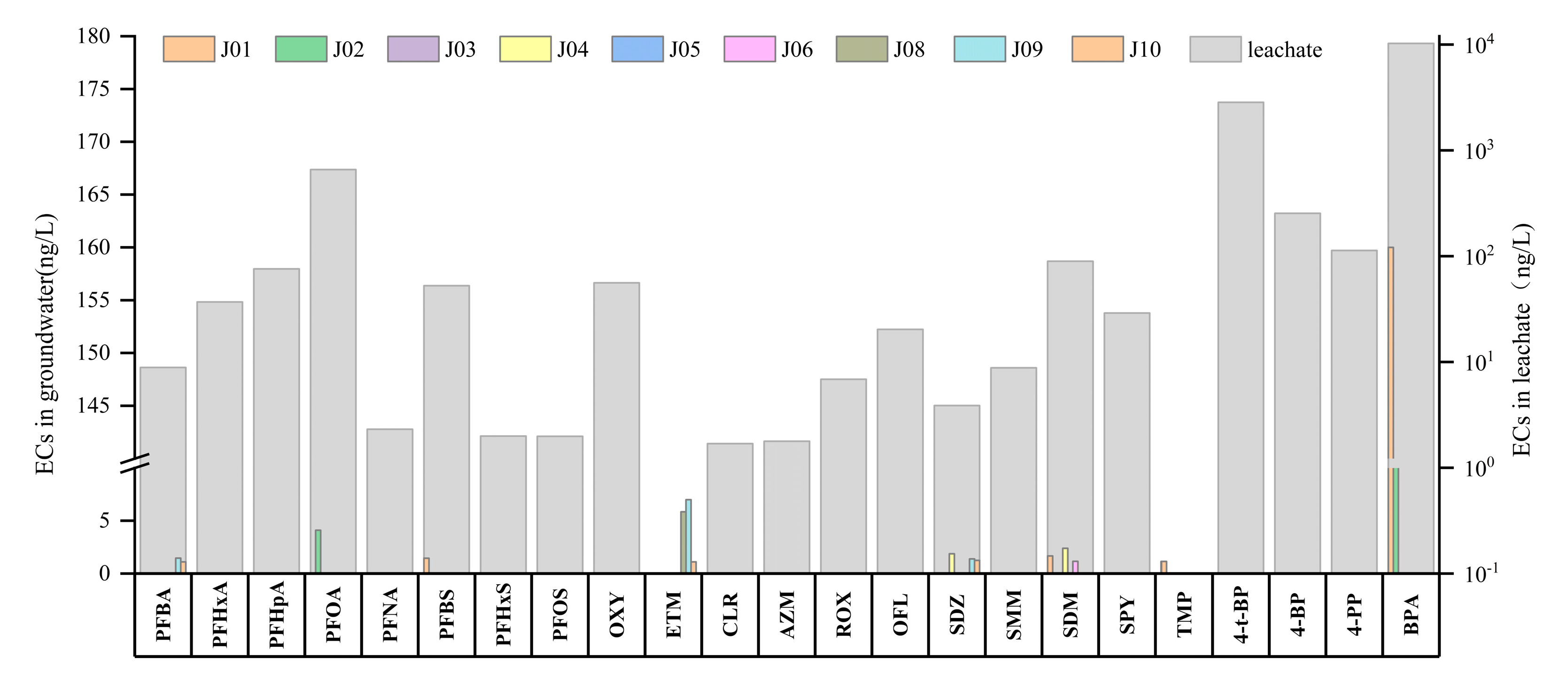
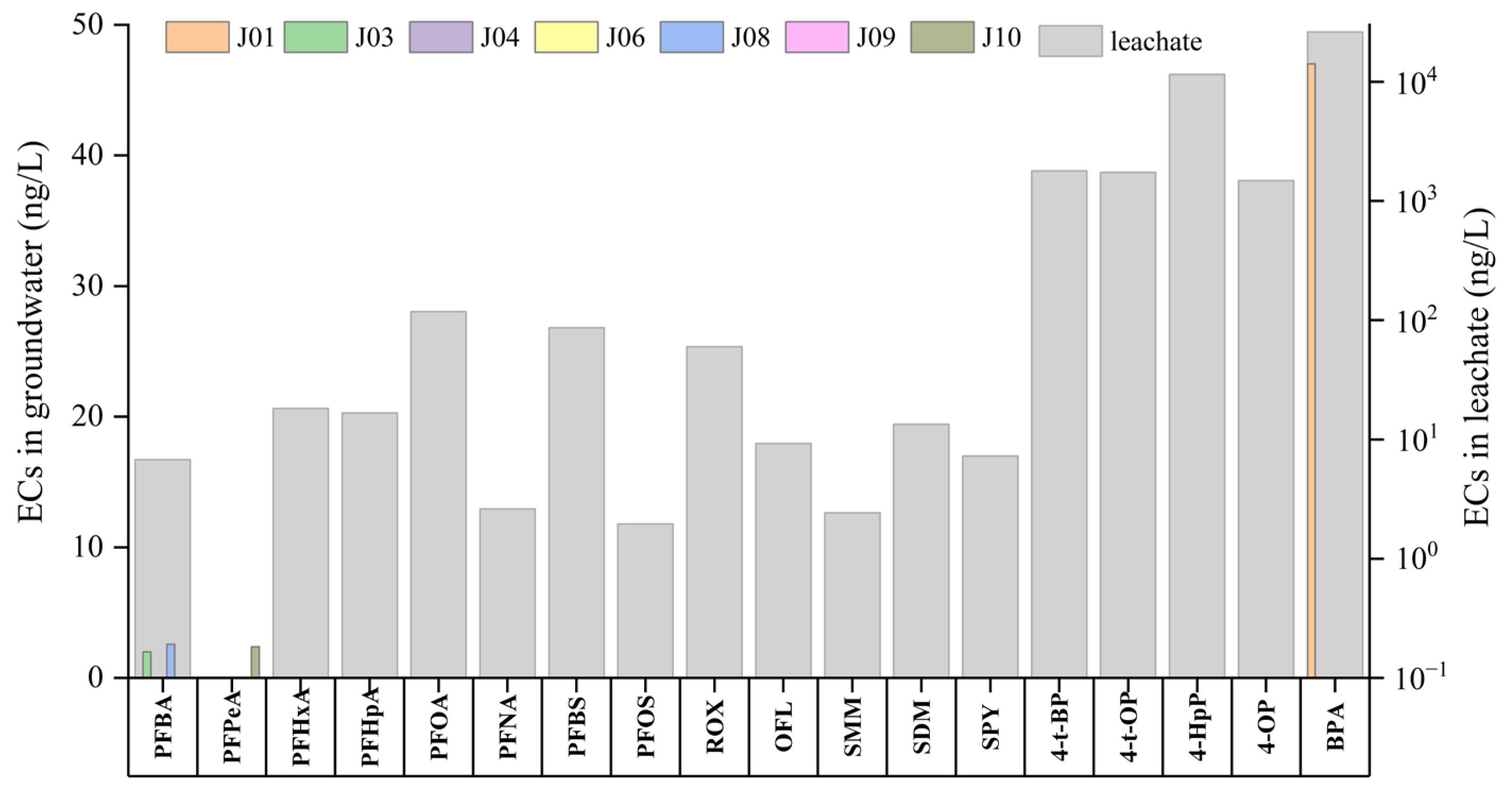
| Landfill | The Setting of Artificial Impermeable Layer | Vadose Zone Thickness (m) | Groundwater Depth (m) |
|---|---|---|---|
| A | 1 mm thick HDPE membrane (2 layers) + 400 g/m2 geotextile (2 layers) + 100 g/m2 geotextile (2 layers) | 9.1–12.8 | 9.45–13.10 |
| B | 1.5 mm thick HDPE membrane (1 layer) + 400 g/m2 geotextile (2 layers) | 25.8–48.9 | 0.17–5.32 |
| C | 2.5 mm thick HDPE membrane (1 layer) + 600 g/m2 geotextile (3 layers) | 0.4–2.4 | 1.50–4.26 |
| D | 2 mm thick HDPE membrane (1 layer) + 600 g/m2 geotextile (1 layer) + 300 g/m2 geotextile (1 layer) + sodium bentonite waterproofing mat 4800 g/m2 (1 layer) | 5–6 | 1.50–4.26 |
Disclaimer/Publisher’s Note: The statements, opinions and data contained in all publications are solely those of the individual author(s) and contributor(s) and not of MDPI and/or the editor(s). MDPI and/or the editor(s) disclaim responsibility for any injury to people or property resulting from any ideas, methods, instructions or products referred to in the content. |
© 2024 by the authors. Licensee MDPI, Basel, Switzerland. This article is an open access article distributed under the terms and conditions of the Creative Commons Attribution (CC BY) license (https://creativecommons.org/licenses/by/4.0/).
Share and Cite
Zhang, N.; Zhang, Z.; Li, C.; Yue, J.; Su, Y.; Cheng, W.; Sun, S.; Chen, X.; Shi, D.; Liu, B. Emerging Contaminants in Landfill Leachate and Groundwater: A Case Study of Hazardous Waste Landfill and Municipal Solid Waste Landfill in Northeastern China. Water 2024, 16, 2575. https://doi.org/10.3390/w16182575
Zhang N, Zhang Z, Li C, Yue J, Su Y, Cheng W, Sun S, Chen X, Shi D, Liu B. Emerging Contaminants in Landfill Leachate and Groundwater: A Case Study of Hazardous Waste Landfill and Municipal Solid Waste Landfill in Northeastern China. Water. 2024; 16(18):2575. https://doi.org/10.3390/w16182575
Chicago/Turabian StyleZhang, Nan, Zhihao Zhang, Chunyang Li, Jiani Yue, Yan Su, Weiguo Cheng, Shoushan Sun, Xi Chen, Deyu Shi, and Bo Liu. 2024. "Emerging Contaminants in Landfill Leachate and Groundwater: A Case Study of Hazardous Waste Landfill and Municipal Solid Waste Landfill in Northeastern China" Water 16, no. 18: 2575. https://doi.org/10.3390/w16182575
APA StyleZhang, N., Zhang, Z., Li, C., Yue, J., Su, Y., Cheng, W., Sun, S., Chen, X., Shi, D., & Liu, B. (2024). Emerging Contaminants in Landfill Leachate and Groundwater: A Case Study of Hazardous Waste Landfill and Municipal Solid Waste Landfill in Northeastern China. Water, 16(18), 2575. https://doi.org/10.3390/w16182575






